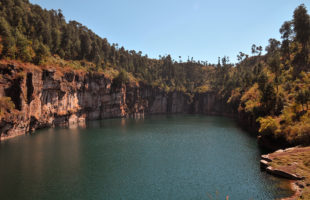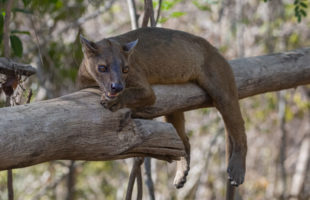On the edge of the Analamerana National Park, between the towns of Ambilobe and Antsiranana (Diego Suarez), lie the red Tsingys (French Tsingy rouge) in the Diana region. It is only 50 km from Antsiranana, but on an increasingly bad road. It is a photographically very worth seeing formation of several hundred small sandstone needles. Unlike the other Tsingys of …
LesenSchlagwort-Archiv: ecotourism
Lily’s waterfall
150 km west of Antananarivo lies Ampefy, near which a large, very worth seeing waterfall rushes. The RN to Ampfey is in good condition, the waterfall itself is reached by a slightly slippery dirt road that can be used by an all-terrain vehicle. Legend has it that a white man once lived here on his plantation, his daughter’s name was …
LesenLake Tritriva
Lake Tritriva is an emerald green lake, located about 15 km from Antsirabe in Madagascar’s central highlands. The next town is Belazao, which is easy to reach via RN34 by 4×4. The lake is of volcanic origin, approximately 160 m deep and part of the eponymic mountain Vakinankaratra region. People of lake Tritriva tell the legend of Rabeniomby and Ravolahanta, …
LesenLemurs, the spirits of the forest
Lemurs are probably Madagascar’s most famous mammals – not for nothing because they originally exist only there and nowhere else in the world. They belong to the strepsirrhine primates and are divided into about 100 different species. The word lemures comes from Latin and refers to the spirits of the dead of ancient Rome, who have little resemblance to the …
LesenReptiles in general
Madagascar is the reptile paradise per se and especially known for its chameleons. 92 of all 213 up to date described chameleon species only occur in Madagascar. They seem to be fabulous creatures with their strange tongue, the independently from eacht other movable eyes and feet and hands transformed into grapsing forceps. Unfortunately, those beautiful animals aren’t very popular with …
LesenAmphibians in general
Especially the rainforests of Madagascar offer an abundance of different frogs for observation and discovery. Almost 4% of the world’s amphibian fauna is found on the island. Especially in the rainy areas on the east coast, you can find countless different species in a small area. In the rainy season, the croaking, chirping, and chirping of the courtship males can …
LesenAn extraordinary predator: The Fossa
Indeed it looks a little strange: The Fossa (Cryptoprocta ferox). The long-stretched body wears a thick tail of almost equal length, and the cat-like head is graced by quite sharp teeth and a big, round nose. And although the Fossa grows only knee-high, it is Madagascar’s largest predator. Both genders reach a maximum body weight of 12 kg, the males …
LesenJungle express
Fianarantsoa is located on the RN7 and can be easily reached via it. From there, the “Jungle Express” with its rustic diesel locomotive from 1936 runs on an old, approximately 163 km long railway line, but even the wagons are hardly younger – here you can experience pure nostalgia and adventure. The line was built during the French colonial times. …
LesenThe crocodiles’ lake
The Lake of Crocodiles is located in northern Madagascar between the cities of Antsiranana (Diego Suarez) and Ambilobe. The next town west of the lake is called Anivorano North, is accessible via the RN6 and belongs to the Antsiranana region. The lake itself is actually called Antagnavo, is of volcanic origin and is known for its countless crocodiles (Crocodilus niloticus …
LesenAnkarana Special Reserve
Ankarana: Ankara is derived from the name of the population living there, the Antankarana. Antankarana means “the people from the rocks”, which refers to the Tsingys typical for the special reserve. Location: Ankarana is located on the RN6, just 110 km south of Antsiranana (Diego Suarez) and about 35 km north of Ambilobe, in northern Madagascar. The reserve is only …
Lesen MADAMAGAZINE Your Magazine about Madagascar
MADAMAGAZINE Your Magazine about Madagascar










